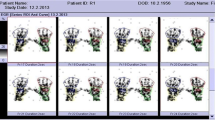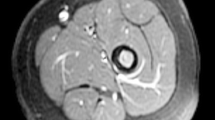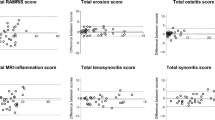Purpose. To estimate disease activity in patients with systemic sclerosis using contrast-enhanced MRI of the skin.
Material and Methods. In a pre-study, sequences of a low-field (0.2 T) scanner (Artoscan, Esaote, Genova, Italy) were optimized for detection of intravenous contrast (0.1 mmol/l Gd-DTPA) in six patients with the autoimmune disease systemic scleroderma. Based on the results of the pre-study, 17 patients with scleroderma (7 sclerotic/10 active inflammatory disease) were scanned using gradient-spoiled 3D GRE sequences (FA 90 °, TR 100 ms, TE 18 ms), which had been established as most sensitive for intravenous contrast. Contrast enhancement of the skin was determined quantitatively by contrast-to-noise ratios (CNR), comparing post- to pre-contrast and dynamic scans (for 6 min, 1 acquisition/min). Patients in the chronic state with sclerodactylia and active inflammation of the hands were considered separately and compared to a control group (n = 10) matched according to age.
Results. CNR increase after intravenous contrast was significantly higher in patients with active disease (86 ± 16 % increase) than sclerosing disease (29 ± 3 %, p < 0.05) and the control group (4 ± 2 %, p < 0.05). The dynamic examination showed a significantly slower decrease after the peak rise in the first minute in patients with active disease (CNR 15.4 ± 0.7 to 14.2 ± 1.4) than in those with chronic disease (14.1 ± 0.5 to 11.3 ± 0.9, p < 0.05).
Discussion. Capillary leakage is the most likely explanation for the increased enhancement in patients with active scleroderma. Using sequences optimized for contrast detection, disease activity in the course of scleroderma and response to therapy can be determined by MRI in the future.
Zusammenfassung
Zielsetzung der Arbeit war die Quantifizierung der Entzündungsreaktion der Haut bei an systemischer Sklerodermie erkrankten Patienten mittels kontrastverstärkter MRT.
Material und Methoden. In einer Vorstudie mit 6 Patienten wurden die Sequenzen eines dedizierten Niederfeldmagnetresonanztomographen (Artoscan, Esaote, Genua, Italien) für den Kontrastmittelnachweis (0,1 mmol/l Gd-DTPA i. v.) optimiert. Basierend auf dieser Sequenzoptimierung wurden 17 Patienten mit systemischer Sklerodermie (7 Patienten mit sklerosierender/ 10 mit aktiv-ödematöser Erkrankung) mit einer 3D GRE-Sequenz mit Gradientenspoiler untersucht (FA 90 °, TR 100 ms, TE 18 ms). Kontrast-zu-Rausch-Verhältnisse (CNR) von nativen und kontrastverstärkten statischen (6 min) und dynamischen (über 6 min, 6mal 1 min) Sequenzen ermöglichten die Quantifizierung der Anreicherung der Kutis. Patienten in der chronischen Phase mit Sklerodaktylie und der ödematösen Phase der systemischen Sklerose sowie eine alterskorrelierten Kontrollgruppe (n = 10) wurden getrennt ausgewertet und verglichen.
Ergebnisse. Kontrast-zu-Rausch-Verhältnisse von nativen im Vergleich zu kontrastverstärkten Sequenzen zeigten eine signifikant stärkere Anreicherung bei Patienten mit aktiv-ödematöser Erkrankung im Vergleich zu Patienten in der sklerosierenden Phase der Erkrankung (86 ± 16 % und 29 ± 3 %, p < 0,05) und im Vergleich zur Kontrollgruppe 4 ± 2 %, p < 0,05). Die dynamische Untersuchung zeigte einen signifikant langsameren Abfall des Kurvenverlaufs nach dem Maximum in der ersten Minute bei Patienten mit aktiv-ödematöser (CNR: 15,4 ± 0,7 auf 14,2 ± 1,4) im Vergleich zur chronisch-sklerosierenden Erkrankung (CNR: 14,1 ± 0,5 auf 11,3 ± 0,9, p < 0,05).
Diskussion. Die wahrscheinlichste Erklärung für die verstärkte Anreicherung bei Patienten mit aktiver Sklerodermie ist das kapilläre „Leakage“. Mit Hilfe von Sequenzen, die intravenöses Kontrastmittel hochsensitiv nachweisen, könnten zukünftig Krankheitsstadium und Therapieerfolge bei systemischer Sklerodermie dokumentiert werden.
Similar content being viewed by others
Author information
Authors and Affiliations
Rights and permissions
About this article
Cite this article
Bonél, H., Messer, G., Seemann, M. et al. MRI of the fingers in patients with systemic scleroderma. Early results of contrast-enhanced examinations on a dedicated MRI system. Radiologe 37, 794–801 (1997). https://doi.org/10.1007/s001170050284
Issue Date:
DOI: https://doi.org/10.1007/s001170050284




